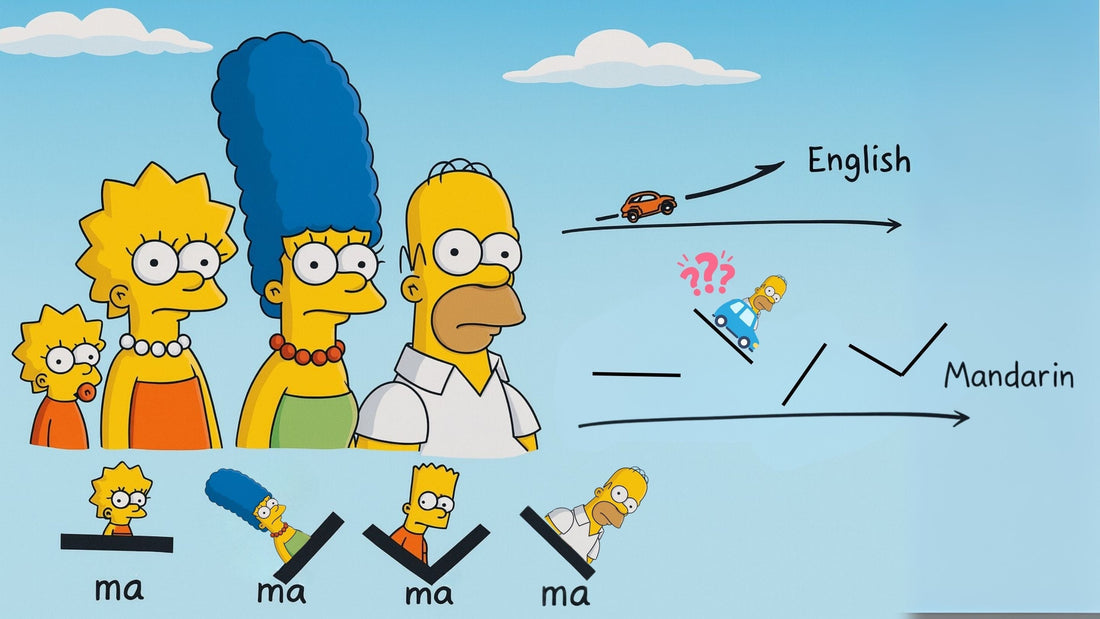
How to Master Chinese Tones in 3 Minutes
How to Master Chinese Tones in 3 Minutes
Estimated reading time: ~3 minutes
Why Tones Matter in Chinese
Mandarin Chinese is a tonal language. That means pitch isn’t just for emotion, it’s part of the word itself. Change the tone, and you change the meaning.
For English speakers, this feels strange. In English, saying something higher or lower just changes mood. But in Chinese, it changes the actual word.
Take the syllable ma for example:
mā (妈) = mother
má (麻) = hemp
mǎ (马) = horse
mà (骂) = scold
Without tones, you’re not speaking Mandarin — you’re just making noise. To show why tones matter so much, here are some classic examples where a single tone mistake completely changes the meaning:

Example 1: Mom vs. Horse
妈妈骂马,马骂妈妈
māmā mà mǎ, mǎ mà māmā
Mom scolds the horse, the horse scolds mom.
This whole sentence is built from just one syllable “ma” in different tones.
Example 2: Thesis Presentation vs. Poop Preparation
1.我下周要答辩 (dá biàn)。
2. 我下周要大便 (dà biàn)。
First one: “I need to defend my thesis next week.”
Second one: “I need to poop next week.”
One tiny tone change, and your serious statement becomes bathroom humor.
Example 3: Love vs. Cancer
1. 他没有钱,只有爱 (ài)。
2. 他没有钱,只有癌 (ái)。
First one: “He has no money, only love.”
Second one: “He has no money, only cancer.”
The difference between ài and ái is just tone — but the meaning couldn’t be more opposite.
These examples show why tones are not “extra.” They are part of the word itself.
⏱️ Master Chinese Tones in 3 Minutes
Now that you know why tones matter, let’s see how to master them quickly.
Step 1: Learn the Four Tone Patterns (1 minute)
1st tone (mā)
Imagine saying “ba” in a high and level, like holding a steady musical note.
Rising, like your voice when you ask a question in English: “Really?”
Start mid and rise up.
3rd tone (mǎ)
Starts mid, falls low, then may rise.
In everyday speech, it usually stays low and flat without rising unless it's alone or at the end of a phrase.
4th tone (mà)
Sharp and falling, like when you give a firm command “Stop!”
Start high and drop sharply.
Pro tip: Draw the shapes of the tones in the air with your hand while you say them.
|
Feature |
1st Tone (bā) |
2nd Tone (bá) |
3rd Tone (bǎ) |
4th Tone (bà) |
|
Pitch Movement |
High, level |
Rising |
Mid to Low (then slight rise if isolated) |
Sharp falling |
|
English Description |
Flat high note |
Like a question |
Low tone, or low dipping |
Command tone |
Step 2: Practice the “ma” Drill
Say out loud: mā, má, mǎ, mà.
Start slowly, then speed up.
It’s like practicing scales on a piano, training your ear and voice together.
Step 3: Anchor Tones with Emotions (1 minute)
Practice 啊 (a) in four tones
1st tone = calm (meditation)
2nd tone = curious (Really?)
3rd tone = doubtful (uh-huh?)
4th tone = serious (No!)
The more you act it out, the faster your brain locks it in.
Want to make tones and characters stick even faster? Try our Bestling Pinyin cards a playful way to build accurate Chinese pronunciation step by step.


